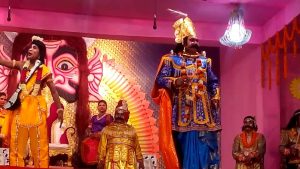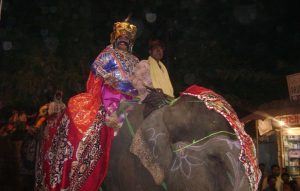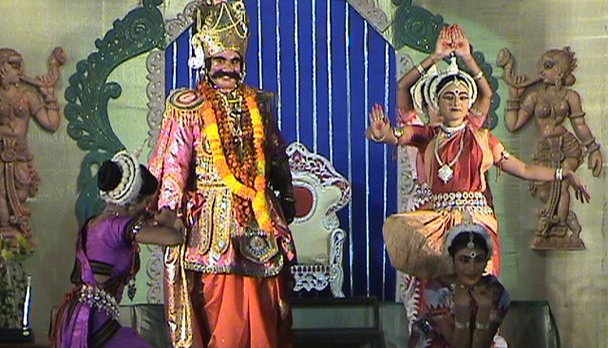By Biranchi Mishra
Odisha is not only a land of magnificent monuments and natural beauties but also of colourful fairs and festivals and dance and drama. Among the plethora of festive occasions, the spectacular Dhanu Yatra of Bargarh, organised for 11 days preceding Pausha Poornima (December-January) is unique in sense and style, grace and grandeur.
When and how the Dhanu Yatra began at Bargarh is not exactly known but elderly people say that such a festival was started towards the end of the 18th century or the beginning of the 19th century. Initially, it was a seven-day affair which was later extended to eleven days.
Based on the Srimad Bhagabata and other works like Mathura Bijaya, Dhanu Jatra is a theatrical presentation of a part of Krishna Leela. The mythological story – from the marriage of Devaki with Basudeva till the death of Kansa – is re-enacted to bring the old myth alive. Here are 10 things that makes the Dhanu Yatra unique and lively:
- It is a drama with a difference as the entire story is enacted, scene by scene, on different locations, as they are narrated to have actually happened.
- The entire topography of Bargarh within a radius of five kilometres turns into a stage, making it the largest open air theatre in the world. Incidentally, the geography of Bargarh region totally conforms to the locales of the puranic descriptions and makes it an ideal venue. Since the starting of Dhanu Yatra till its end the city of Bargarh is treated as Mathura. The Jeera river on the outskirts of Bargarh serves as the river Jamuna. Amapali on the other side of the river becomes the mythical Gopapura. Even a mango grove and a pond there become Vrindavan and lake Kalindi respectively. Nowhere, a play has been made to achieve such a vast magnitude with such naturality. The viewers have to move from place to place to watch the action live.
- All scenes are enacted on the natural environment and no set, except for the durbar of King Kansa, is made. It gives the drama a natural ambience and feel. A an elephant is engaged for the royal transport of King Kansa. A chariot is made for Akrura’s visit to Gopapura.
- Another unique feature of Dhanu Yatra is that all people – local residents as well as visitors – become participants in the 11-day drama. While the lead roles are done by few chosen actors, common people also become characters playing their roles as subjects of Mathura in the drama. Nowhere it is seen that such a large number of spectators also become a part of a drama.
- The enactment is so lively that the people feel physically transported to Dwapara Yuga. It seems for a moment as if Kansa is the de-facto administrator. He would summon any one including government officials like the Bargarh collector. Even the ministers of the state government also obey, albeit playfully, his command while in Bargarh during the festival. The elderly people are so emotionally attached that they literally accept the two children acting as Krushna and Balaram as real gods and worship their feet with all reverence as they do in the temples. The people of Amapali give up non-vegetarian food during the period.
- This is a play with an unwritten script. Keeping in view the story line of the episodes, the characters speak the dialogue extempore in their own way. While the lead characters wear costumes befitting their roles, others are in their normal dress. It can be safely viewed as a folk play.
- The scenes are enacted in the afternoon and evening hours every day. However, cultural programmes continue till the wee hours on makeshift stages for the entertainment of the people. The past blends with the present with ease.

- Dhanu Yatra happens to be an equivalent of theatre that directly relates to the sphere of enactment of the histrionic arts. It is a branch of performing art in dramatic form, defined as what occurs when one or more persons, isolated in time and/ or space, present themselves to one another. The concept of theater (derived from the ancient Greek word ‘theatron’ meaning the seeing place), has been evolved since the dawn of civilisation due to the human tendency of story-telling. Dhanu Yatra appropriately fits in to this definition and concept.
- The festival does not in any way interfere with the normal routine of the city where everything goes on as usual along with the festive mood. There is no imposition or restriction but it is so disciplined that there is no dislocation. However, the district administration keeps a vigilant watch on the law and order situation all the time. In fact, the event, which was initially organised by a group of local residents, is now being organised a under the direct supervision of the district administration.
- Selection of the period of the Dhanu Yatra is also interesting and significant. Bargarh is an agrarian area and the people are mostly farmers. The month of Pausha is the time for harvest and after that it is celebration time. There is a popular saying in Sambalpuri: “Kansa rajar bansha budu, Kansa male khaema ladu” (let the dynasty of king Kansa come to end, we shall take sweets when Kansa dies). Pausha Purnami therefore coincides with the day of Kansa’s end.
|
|




